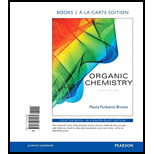
(a)
Interpretation: To predict the products for the given reactions.
Concept introduction: The
(b)
Interpretation: To predict the products for the given reactions.
Concept introduction: The carboxylic acid and its derivatives undergo nucleophilic acyl substitution reaction. The incoming group is called as a nucleophile and the substituent that departs from a molecule is known as leaving group. If the attacking group is a good base as compared to the substituent that is already present than attacking group will replace the existing substituent.
(c)
Interpretation:
To predict the products for the given reactions.
Concept introduction:
The carboxylic acid and its derivatives undergo nucleophilic acyl substitution reaction. The incoming group is called as a nucleophile and the substituent that departs from a molecule is known as leaving group. If the attacking group is a good base as compared to the substituent that is already present than attacking group will replace the existing substituent.
(d)
Interpretation:
To predict the products for the given reactions.
Concept introduction:
The carboxylic acid and its derivatives undergo nucleophilic acyl substitution reaction. The incoming group is called as a nucleophile and the substituent that departs from a molecule is known as leaving group. If the attacking group is a good base as compared to the substituent that is already present than attacking group will replace the existing substituent.
Want to see the full answer?
Check out a sample textbook solution
Chapter 15 Solutions
Organic Chemistry, Books a la Carte Edition (8th Edition)
- 6. The reaction between aniline and nitrous acid at low temperature yields A) an N-nitroso amine B) a diazonium salt C) a nitrile D) an amine nitrite salt 7. An organic nitrogen compound, X, gives ammonia on warming with dilute aqueous sodium hydroxide, X could be A) ethanamide B) ethylamine C) phenylamine D) amino ethanoic acidarrow_forwardReactions of Carboxylic Acids - Fisher esterification: Acid-catalyzed ester formation from carboxylic acid and alcohol OH H₂SO4 OH - Carboxylic acid: conversion to acyl halides: SOCI₂ RCO₂H + SOCI₂ (w/ pyridine) → RCOCI SOCI₂ CH3OH CH3COH Reactions of Amide NH₂ 1. LiAlH4 2. H₂Oarrow_forward1. What is the reaction Benzoic acid+ NaOH+H20+HCL yield? Please write in chemical structure ! 2. What is the reaction p-nitroaniline + H2O+ HCL+ NaOH yield?arrow_forward
- Write the equation for the following reactions. Name and write the structure of the major product formed in the given reaction. a. isopentylbromide + NH3(aq) b. N,N-dimethylaniline + acetic acid c. ethyl-n-butylamine + benzyl chloride d. ethylpropylamine + benzoyl chloride e. isopentylamine + acetoyl chloridearrow_forwardAccount for the fact that treating propenoic acid (acrylic acid) with HCl gives only 3-chloropropanoic acid.arrow_forwardAmino acids such as glycine are the building blocks of large molecules called proteins that give structure to muscle, tendon, hair, and nails. a. Explain why glycine does not actually exist in the form with all atoms uncharged, but actually exists as a salt called a zwitterion. b. What product is formed when glycine is treated with concentrated HCl? c. What product is formed when glycine is treated with NaOH?arrow_forward
- SYNTHESIS OF ESTERS VIA NUCLEOPHILIC ACYL SUBSTITUTION Write the chemical equation involved in the reaction between the excess acid and NaHCO3. Explain why NaHCO3 is preferred over NaOH for the neutralization of excess acid. How was excess alcohol eliminated from the crude product.arrow_forwardWhich of the following reactions will result in the formation of an acyl halide? Select one: a. The reaction of a carboxylic acid with phosphorus trichloride. b. The treatment of an alcohol with ethyl bromide. c. The reaction of an ester with hydrochloric acid. d. The addition of an alkene to dilute hydrochloric acid.arrow_forward6. Complete the following aqueous reactions: a. N-methylethanamide + NaOH b. N,N-diethylpropanamide + HBr → c. What are these reactions called?arrow_forward
- MCQ 17: Carbonyl compounds when oxidized easily to form carboxylic group involves A. aldehydes B. ketones C. haloalkanes D. estersarrow_forwardH NH₂ ཡིནྣཾ ༥ ཨ ཨནྡྷ༥ ༠ ཨི་ཝཱ, ཙ ཨ་ར༩ H NH3+ the acidity of the amine ion drives the reaction to shift toward the conjugate base of the carboxylic acid product. the resulting carboxylic acid ion is a weaker base than an acetate ion. O aldehydes are more reactive toward nucleophiles than ketones. Onucleophilic attack occurs preferentially at the less hindered carbon of the formyl group.arrow_forwardCan salicylic acid undergo an SN1 reaction?arrow_forward
 Organic ChemistryChemistryISBN:9781305580350Author:William H. Brown, Brent L. Iverson, Eric Anslyn, Christopher S. FootePublisher:Cengage Learning
Organic ChemistryChemistryISBN:9781305580350Author:William H. Brown, Brent L. Iverson, Eric Anslyn, Christopher S. FootePublisher:Cengage Learning Organic Chemistry: A Guided InquiryChemistryISBN:9780618974122Author:Andrei StraumanisPublisher:Cengage Learning
Organic Chemistry: A Guided InquiryChemistryISBN:9780618974122Author:Andrei StraumanisPublisher:Cengage Learning Chemistry for Today: General, Organic, and Bioche...ChemistryISBN:9781305960060Author:Spencer L. Seager, Michael R. Slabaugh, Maren S. HansenPublisher:Cengage Learning
Chemistry for Today: General, Organic, and Bioche...ChemistryISBN:9781305960060Author:Spencer L. Seager, Michael R. Slabaugh, Maren S. HansenPublisher:Cengage Learning


